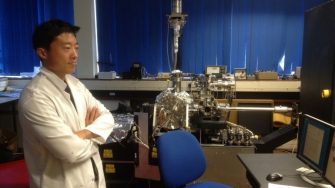
"Being one of the top 50 universities in the world, I could not think of a better place than UNSW to begin my career as a materials scientist."
What did you study?
I studied materials science and engineering majoring in Physical Metallurgy at UNSW.
Why did you choose to do a Materials Science degree?
I chose materials science because it was a unique field of study that bordered on both science and engineering. There are aspects of materials science which draws heavily on fundamental chemistry, biology and physics and another side which is focused on real life applications of materials technology. Being one of the top 50 universities in the world, I could not think of a better place than UNSW to begin my career as a materials scientist.
What was your experience being a Materials Science student?
Thoroughly enjoyed my time as an undergraduate student at UNSW as the teaching it provided were very enlightening and each lecturer and professor were very passionate about the subject and it was reflected in their teaching style. I was on a co-op scholarship during my time at UNSW which enabled me to undertake work experience at various companies and help me gain bearings on what I want to do when I graduated. I am always grateful to UNSW for the opportunities that it gave me. I don’t think I would be where I am today if I didn’t attend Materials Science at UNSW.
Where are you working now and what is your role?
I am currently working at the Australian Nuclear Science and Technology Organisation (ANSTO), it is one of Australia’s leading research institutions heavily involved with nuclear technology research. I work in the Nuclear Fuel Cycle group at ANSTO alongside many talented scientists and our role is to under the phenomena of radiation damage in materials. Radiation damage of materials is a huge topic of research and it involves understanding transmutation, cavity formation and amorphization of materials under extreme environments of high temperature, stress and irradiation. Materials typically become embrittled under such conditions so it is important to understand the underlying mechanisms as well as means by which they can be better designed to prolong their lifetime.
What does your current role involve?
Since I started at ANSTO, a large part of my time has been involved with developing the capability to fabricate and test micron sized dogbone samples 5-10 microns in diameter. This technique is particularly relevant for materials that have undergone ion irradiation where the damage penetration is typically 5-10 microns in depth. As well, it has great applications for 3D printed materials or any sample from which it is difficult to fabricate a macro sized dog-bone sample from.
After graduating, how did your career path evolve?
During my undergraduate degree, I was able to achieve a university medal which greatly aided my application to pursue postgraduate study. I was extremely lucky in obtaining a scholarship from Oxford University to continue my studies there as a PhD student in materials science, a degree which I completed in 2015. After achieving my PhD, I was offered a permanent role as research scientist at ANSTO and I have been working at ANSTO ever since.
Do you have any advice for school leavers considering studying Materials Science at UNSW Sydney?
I would definitely recommend studying Materials Science at UNSW. Around Australia, it would be difficult to find an educational institute and degree that affords you so much career opportunities and have such a collection of talented educators as the material science department at UNSW. Furthermore, a degree in Materials Science at UNSW is very flexible and doesn’t necessarily lock you into a strictly material science career. I have met Materials science graduates who have gone into law, finance and civil engineering after graduation.
Please share any fond memories you have of your time studying Materials Science at UNSW Sydney.
Playing soccer at the Oval!
